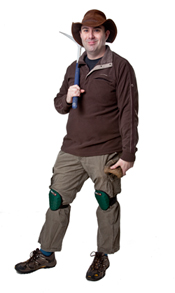Prof Paul Barrett
The intricate puzzles of skulls inspire our herbivorous dinosaur expert to discover how the living creatures would have interacted with their world.

Early aspirations
Prof Barrett had brief aspirations of being a vet but decided that living animals smell and bite too much. Now he studies dinosaurs, enjoying the detective work that goes into studying animals he couldn’t possibly see alive today.
The first time Prof Barrett got his hands on real dinosaur material was at the Natural History Museum on a summer placement during his undergraduate degree in zoology. He was sorting bones of the Hypsilophodon, a small plant-eating dinosaur only known from the Isle of Wight.
Super specimens
A Hypsilophodon skull is still one of his favourite specimens, but another is the Stegosaurus skeleton that joined the Museum's collections in late 2013. Prof Barrett is particularly excited about studying the skull, as Stegosaurus skull material is very rare.
‘Skulls are really neat three-dimensional jigsaw puzzles,’ he says. ‘There’s a lot of information in a skull about the evolutionary history of an animal, and also about its biology. It tells you how well it could see, how well it could smell; it tells you what its brain was like, what its ear was like, how it was eating.’
How dinosaurs eat is a fascination for Prof Barrett, and his ideal find would be dinosaurs that have features of both meat-eaters and plant-eaters. Plant-eating dinosaurs evolved out of meat-eaters, but there are few specimens ‘caught in the act’ of transforming from one to the other.
Bringing the past to life
Prof Barrett can tell a lot about dinosaurs by looking at their bones and comparing them to living animals. His research can show how a dinosaur moved, what they looked like, their skin texture and even what noises they made. Using the Museum’s CT scanner to look at inner ear bones of dinosaurs he can tell what range of sounds they could hear, and therefore make.
Prof Barrett spends much of his time researching, writing papers and supervising students. He likes getting away on visits to conferences and other museums too, when he’s not digging up new finds around the world.